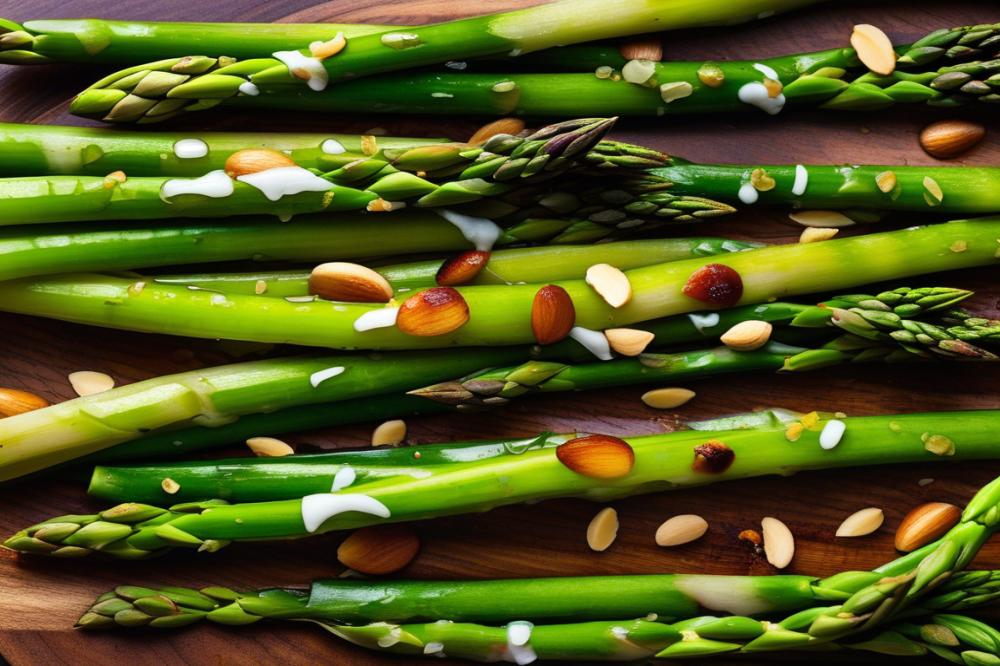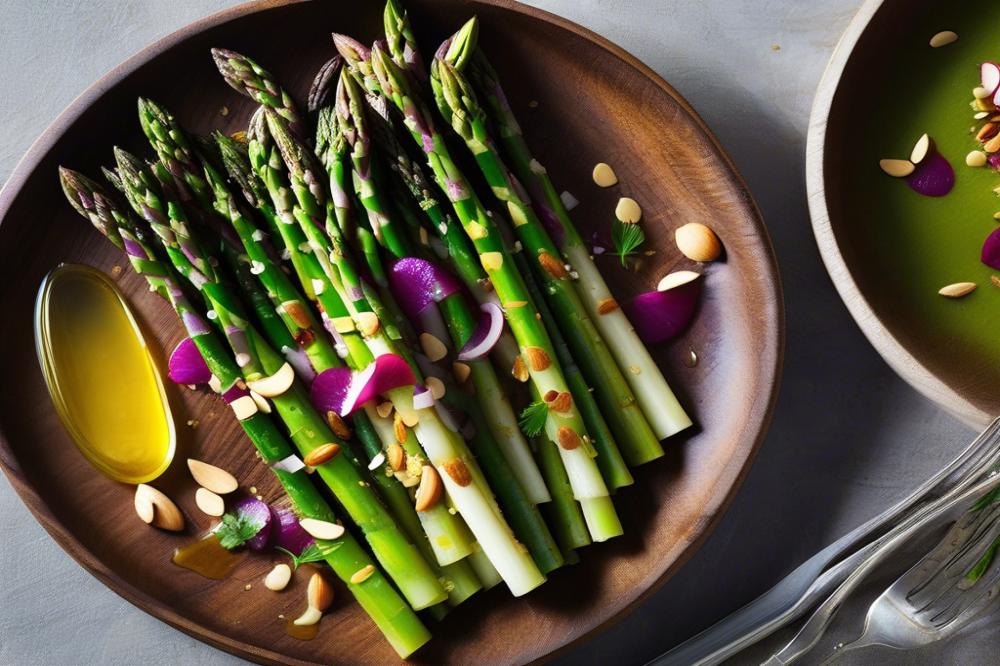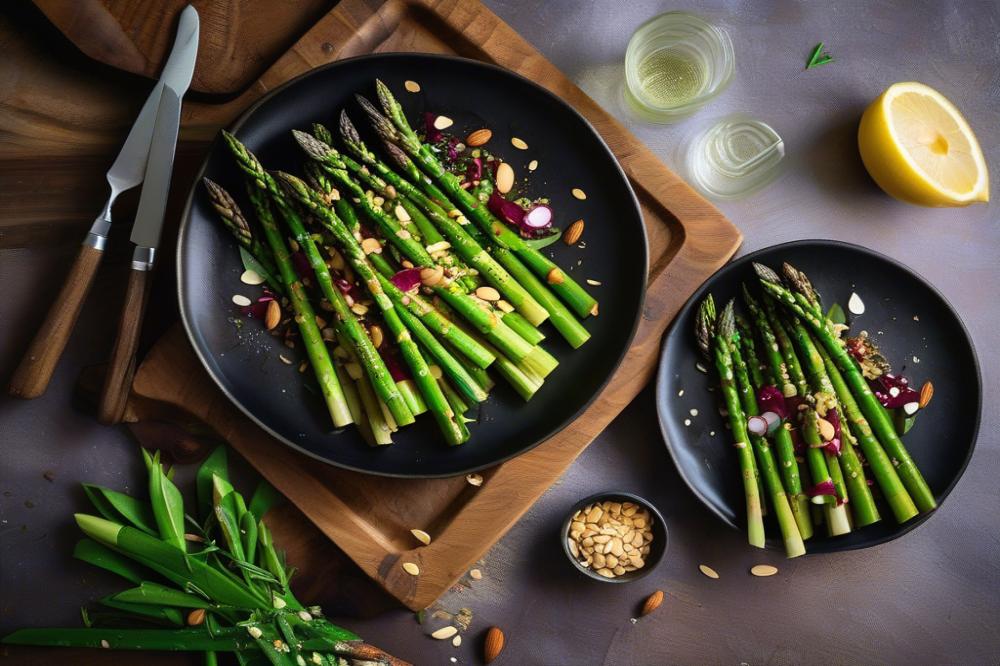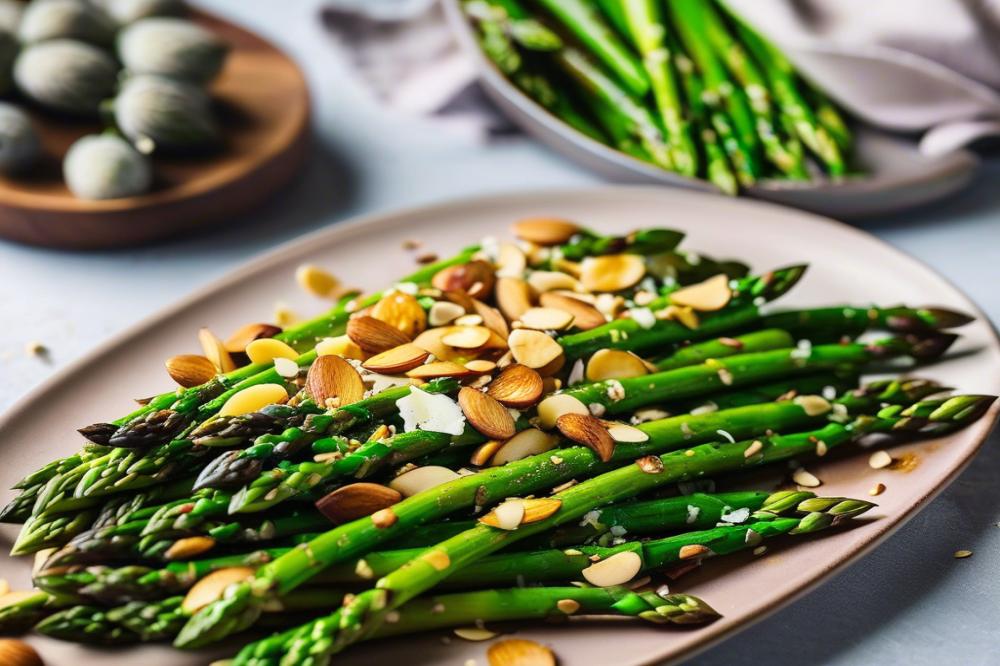Healthy Salads: A Vital Part of Your Diet
Salads play an important role in a balanced diet. Many people seek nutritious options to incorporate more fresh produce into their meals. A well-prepared salad can pack a punch of vitamins, minerals, and fiber. Choosing healthy recipes can help maintain good health and support a vibrant lifestyle.
Roasted asparagus and Almond Salad stands out among various options. This dish features tender roasted asparagus, crunchy almonds, and a blend of flavors that delight the palate. Seasonal ingredients often enhance the appeal, making it especially suitable for spring.
Flavors come alive in this salad. The earthiness of roasted vegetables combines beautifully with the nutty taste of almonds. Each bite offers a delightful texture that balances crisp greens with creamy dressings. Not only is it delicious, but it also boasts numerous health benefits. This gluten-free vegetable dish is rich in antioxidants and heart-healthy fats. Overall, it makes for an easy recipe that can be enjoyed at any meal. Whether as a side or a main attraction, Almond Salad might just become a staple.
Roasted Asparagus Salad: Ingredients and Instructions

Ingredients List
- Fresh asparagus
- Olive oil
- Garlic
- Sliced almonds
- Lemon juice
- Salt and pepper
- Optional: feta cheese or other toppings
Cooking Instructions
Begin by preheating your oven to 400°F (200°C). This step is crucial for getting those flavorful roasted vegetables just right.
Next, wash the asparagus thoroughly. Trim the tough ends, which can be fibrous. Season the spears with a good drizzle of olive oil, minced garlic, and a sprinkle of salt and pepper. Toss them until they are well coated.
Spread the asparagus in a single layer on a baking sheet. Roast in the oven for about 15-20 minutes. The goal is to have them tender and slightly crisp on the edges.
While the asparagus is roasting, take a small skillet and toast the sliced almonds over medium heat. This usually takes about 5 minutes. Keep an eye on them to avoid burning; they need to be golden brown.
After everything is cooked, it’s time to assemble your salad. Place the roasted asparagus on a plate. Sprinkle the toasted almonds on top. Add a squeeze of fresh lemon juice for zest. If you like, crumble feta cheese over the dish or add your favorite toppings.
Tips for making it an easy recipe
Choose asparagus that is firm and vibrant for the freshest flavor. This healthy recipe can be made with just a few ingredients, making it effortless for beginners.
Consider using leftover roasted vegetables from a previous meal if you have them. They pair nicely with this nutritious salad. You can also swap out almonds for other nuts based on preference.
Keeping it gluten-free is simple with this dish. Feel free to experiment with different seasonings to find what you love best. This spring salad can really shine with a personal touch!
Nutritional Benefits of Key Ingredients

The Roasted Asparagus and Almond Salad showcases a variety of ingredients that come together to provide numerous health benefits. Asparagus, a star in this healthy recipe, is rich in vitamins A, C, E, and K. It also contains fiber, which aids in digestion and keeps you feeling full.
Almonds add a crunchy texture and a wealth of nutrition. They offer healthy fats and a good amount of protein. Vitamin E is another bonus from almonds, acting as a powerful antioxidant. Additionally, these nuts contain magnesium, which supports muscle function and heart health.
Drizzling olive oil over the salad enhances flavor while contributing to heart health. This oil is packed with beneficial fats and antioxidants. Using it not only makes the dish tastier but also adds a layer of nutrition.
Lemon juice brightens the salad and provides a punch of vitamin C. This nutrient is essential for a healthy immune system and aids in digestion. Adding lemon makes the dish refreshing and zesty.
Overall, this nutritious salad is a well-rounded vegetable dish. With its combination of roasted vegetables, healthy fats, and protein, it makes for an easy recipe, especially during spring. Eating this dish ensures you get a variety of nutrients that support overall wellness. Plus, it’s gluten-free, making it suitable for many diets.
Using Roasted Vegetables in Salads

Roasted vegetables can elevate a salad, adding depth in flavor and an exciting texture. When vegetables are roasted, their natural sugars caramelize, creating a sweeter taste that complements other ingredients. This simple cooking method also softens vegetables, making them tender and enjoyable to eat. A nutritious salad featuring roasted asparagus and almonds is a perfect example of this.
Carrots, bell peppers, and Brussels sprouts are excellent choices for roasting in salads. Carrots become sweeter, while bell peppers develop a rich, smoky flavor. Meanwhile, Brussels sprouts add a crunchy bite with a subtle earthiness. Including such vegetables will create a more diverse and flavorful salad experience.
Incorporating roasting into your salad prep is straightforward. Start by chopping your vegetables into uniform pieces to ensure even cooking. Toss them with a little olive oil, salt, and pepper. Spread them out on a baking sheet and roast until they turn golden and slightly charred. Once cool, mix the roasted vegetables with fresh greens, nuts, and your favorite dressing. This easy recipe guarantees that your salads are not only vibrant but packed with nutrients. Notably, this method keeps your dish gluten-free and highlights seasonal ingredients for a refreshing spring salad.
Seasonal Variations and Pairings
Adapting the Recipe for Spring
Spring brings fresh new flavors. As asparagus is harvested, consider adding seasonal herbs like basil or mint. These fresh ingredients enhance the salad’s taste. Include other vegetables like radishes or peas to brighten the dish. Colorful produce makes your meal visually appealing and nutritious. A spring salad can be a delightful addition to your dinner table.
Pairing with Proteins
Adding protein creates a fulfilling meal. Chicken is an excellent choice; it adds lean meatiness. For seafood lovers, consider grilled salmon. Its rich taste pairs wonderfully with roasted vegetables. Chickpeas are also a great option. They are packed with protein and make your gluten-free salad heartier. Each of these additions contributes different flavors and textures.
Recommended Dressings and Toppings for Added Flavor
Dressings can elevate any dish. A simple lemon vinaigrette works nicely, balancing the flavors. For a creamier option, try a yogurt-based dressing. Adding crushed garlic or Dijon mustard can complement your healthy recipe. Other enticing toppings include crumbled feta or shaved Parmesan. Roasted almonds provide a crunchy contrast to the tender asparagus. This nutritious salad is as versatile as it is delicious.
Final Thoughts on Roasted Asparagus and Almond Salad
Roasted asparagus and almond salad offers numerous health benefits. This dish is rich in vitamins and minerals, providing essential nutrients that support overall well-being. Asparagus alone is known for its high fiber content, which promotes good digestion and helps maintain a healthy weight. Almonds contribute healthy fats and protein, making this salad both nourishing and satisfying.
Incorporating more nutritious salads into daily meals is a smart choice. They can effortlessly enhance your diet and introduce a variety of flavors and textures. Each season brings new ingredients, allowing you to adapt and explore. Don’t hesitate to get creative with your salads, mixing in different vegetables, nuts, and dressings.
Consider the versatility of a healthy recipe like this one. It can serve as a side dish or even a main course with the addition of proteins such as grilled chicken or chickpeas. A simple combination of fresh ingredients allows for customization based on personal taste. Enjoying salads regularly not only keeps meals interesting but also encourages a balanced diet.



